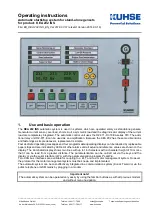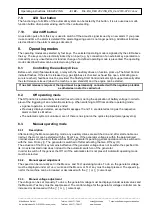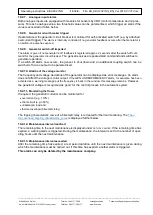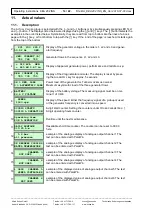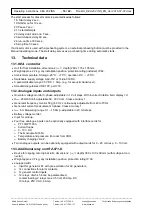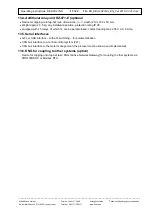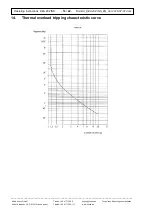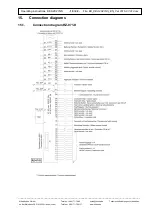
Operating instructions KEA 202 INS -
10 / 22
- File:
BA_KEA 202 INS_EN_Ver 2016-07-01.docx
______________________________________________________________________________________
Alfred Kuhse GmbH
Telefon: +49 4171-798-0
kuhse@kuhse.de
Technische Änderungen vorbehalten
An der Kleinbahn 39, D-21423 Winsen (Luhe)
Telefax: +49 4171-798-117
www.kuhse.de
8.4.
Auto operating mode
8.4.1.
Description
For an automatic start (using the remote start command ), any auxiliary drives are switched on and the para-
metrised start program is triggered after the start function is enabled. If the genset has not started at the end
of the start program, the failed start alarm is issued and the automatic system inhibited.
After the genset has started up, the generator is switched on as soon as the nominal generator voltage and
frequency are reached.
After removing the start command, the delay time is switched (switch-off delay). The generator is switched
off then. To avoid heat accumulation, the genset switches the generator off, continues to run without load for
the set run-on time and is then shut down.
8.4.2.
External start order
The start can be enabled using two remote start commands :
Start with switching (remote start WITH load transfer) (terminal 18)
Start without switching (remote start WITHOUT load transfer) (terminal 25)
Sprinkler requirement (terminal 23).
For an automatic start with a generator switch-on, the genset starts up and switches to generator operation.
The generator will be switched off equally after deactivating the remote start.
The Input Start without switching on is provided for e.g. supply voltage sensitive consumers. For providing
e.g. a fast availability for supplying power, the genset can be started via this input. Only the starting program
runs down, no generator connection takes place. If a remote starting command with generator switch-on is
given, generator connection takes place.
8.5.
Test operating mode
After selecting the test position, any auxiliary drives are switched on and the parametrised start program is
triggered after the start function is enabled. If the generator voltage with its voltage and frequency values are
within the nominal ranges, generator operation can be switched on using the G
EN
.-O
N
(
I
) key resp. switched
off using the G
EN
.-A
US
(
O
)arranged in the mimic diagram.
If a remote start command with switching occurs during test operation, the system switches to generator op-
eration. In these cases, it is no longer possible to switch off the generator circuit breaker manually.
In order to switch off the genset, the Off or (if the automatic start is not present) Automatic operating mode
must be selected.
9.
Sprinkler operation
The following functions are intended for the operation of an electrical sprinkler pump:
Switching over of all alarms to be switched off to warning
Start program with 10 (parametrisable) start attempts
for the duration of the start-up time of the sprinkler pump in accordance with the parameterisation switch-
off of the emergency power consumers or no interruption of the emergency supply.
For ending the sprinkler requirements in accordance with the parameterisation:
Cancellation of sprinkler operation after the
SPRINKLER RUN
-
ON TIME
or
only manually switched off
The time stage for sprinkler operation run-on time can be set in the range 10 to 2400 seconds. If it is para-
metrised to 0 sec., the genset does not automatically switch off.
In this case, the display of the Off operating mode flashes.
The genset can then only be stopped by the quick stop or Off operating mode.
The interruption of the emergency current operation for the switching on of the sprinkler pump can be para-
metrised in the range 0 to 24 sec. For the 0 sec. setting, there is no switching-off of the consumers. The
switching-off of the consumers begins with the sprinkler operation signal.
If the sprinkler requirement is met, the emergency power consumers are also switched on during a power
failure or remote start. For return of the power or after removal of the remote start command, the emergency
power consumers are switched back to the mains after the switch-back delay.
Switching off the generator or shutting it down due to an alarm is suppressed. However, if a switch-off alarm
occurs, the collective switch-off alarm is output.

